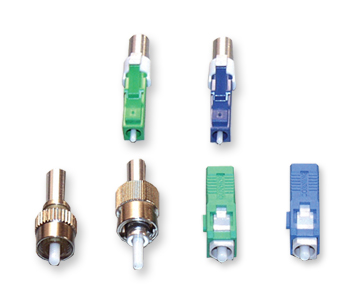Network interface card is the full name of NIC, also known as a network adapter, LAN adapter. It is a computer hardware being used to connect the computers to the networks by preparing, sending, and controlling data on the network. FiberStore provides PCI/PIC-Express 100M, 1000M and 10G fiber optic network cards, they are available in both multimode and single mode configurations with ST, SC, MTRJ, or LC connectors, and SFP for Gigabit.
Network Interface Cards
As we know from the Wikipedia, a network interface card, known as Fiber Optic Network Interface Card, which is simply a computer circuit board or card that is installed in a computer so that to connect to the network. Personal computers and workstations on a local area network (LAN) typically contain a network interface card specifically designed for the LAN transmission technology, such as Ethernet or token ring. NIC adapter hardware is the form factor os an add-in card such as PCI card.
As we know from the Wikipedia, a network interface card, known as Fiber Optic Network Interface Card, which is simply a computer circuit board or card that is installed in a computer so that to connect to the network. Personal computers and workstations on a local area network (LAN) typically contain a network interface card specifically designed for the LAN transmission technology, such as Ethernet or token ring. NIC adapter hardware is the form factor os an add-in card such as PCI card.
NIC cards work with wired or wireless connection, as they support either wired Ethernet or Wifi wireless standards. Ethernet NICs plug into the system bus of the PC an include jackets for network cables, while WiFi NICs contain built-in transmitters/receivers. In most computer nowadays, many NICs are pre-installed by the manufacturer. They features a speed rating such as 11 Mbps, 54 Mbps or 100 Mbps that suggest the general performance of the unit.
PCI and PCI Express
PCI is short for Peripheral Component Interconnect. It is regarded as a local computer bus for attaching hardware device in a computer. PCI is part of local bus standard. The PCI bus supports the functions found on a process bus but in as standardized format that is independent of any particular processor’s native bus. PCI has been a versatile, functional way to connect sound, video and network cards to a motherboard.
PCI is short for Peripheral Component Interconnect. It is regarded as a local computer bus for attaching hardware device in a computer. PCI is part of local bus standard. The PCI bus supports the functions found on a process bus but in as standardized format that is independent of any particular processor’s native bus. PCI has been a versatile, functional way to connect sound, video and network cards to a motherboard.
As processors, video cards, sounds cards and network has gotten faster and more powerful, the shortcoming of PIC appears. Because PCI has a fixed width of 32 bits and can handle only 5 devices at a time. To overcome these shortcomings, the PCI Express appears with improvements over the old PIC, including higher maximum system bus throughput, lower I/O pin count and smaller physical footprint, better performance-scaling for bus devices, a more detailed error detection and reporting mechanism and native hot-plug functionality.
A key difference between PCI Express bus and older PCI is the bus topology. PCI uses a shard parrel bus architecture, where the PCI host and all devices share a common set of address/data/control lines. In contrast, PCI Express is based on point to point topology, withe separate serial links connecting every device to the root complex.
Gigabit PCI Express Network Card
Gigabit PCI Express network card is gigabit based network adapter card that offers a versatile solution that allows servers and desktop PCs to connect to a Gigabit network through a PCI-E slot. It can provide full Gigabit bandwidth capacity with the dedicated bandwidth of the connected PCI Express bus to provide dependable connectivity. Gigabit PCI express network card is fully compliant with the 10/100/1000 Mbps IEEE 802.3 specification, this PCIe Gigabit NIC provides a maximum transfer speed of 1000Mbps (bidirectional - 2000Mbps total) - ensuring a high performance network connection. This adapter also offers 10/100/1000Mbps data rate auto-negotiation and full duplex operation that helps to optimize connection speeds and provide efficient performance.
Gigabit PCI Express network card is gigabit based network adapter card that offers a versatile solution that allows servers and desktop PCs to connect to a Gigabit network through a PCI-E slot. It can provide full Gigabit bandwidth capacity with the dedicated bandwidth of the connected PCI Express bus to provide dependable connectivity. Gigabit PCI express network card is fully compliant with the 10/100/1000 Mbps IEEE 802.3 specification, this PCIe Gigabit NIC provides a maximum transfer speed of 1000Mbps (bidirectional - 2000Mbps total) - ensuring a high performance network connection. This adapter also offers 10/100/1000Mbps data rate auto-negotiation and full duplex operation that helps to optimize connection speeds and provide efficient performance.
As a professional fiber optic network solutions provider, FiberStore offers full ranges of PCI network interface cards includes 100M PCI/PCI-E NIC, PCI-E 1000M NIC,and PCI-E 10G SFP+ Ports. For specifications of each type, please welcomewww.fiberstore.com
